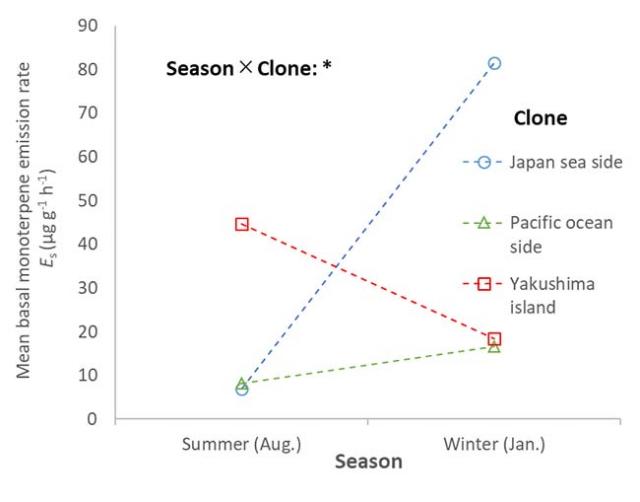Home > Research > Research Results > Research Results 2020 > Seasonal and regional variations in monoterpene emission rate of Japanese cedars after ozone exposur
Update:January 22, 2020
Main content starts here.
Seasonal and regional variations in monoterpene emission rate of Japanese cedars after ozone exposur
| Article title |
Seasonal changes in interclone variation following ozone exposure on three major gene pools: An analysis of Cryptomeria japonica clones |
|---|---|
| Author (affiliation) |
Takafumi Miyama (a)、Hiroyuki Tobita (b)、Kentaro Uchiyama (c)、Kenichi Yazaki (b)、Saneyoshi Ueno (c)、Akira Uemura (b)、Asako Matsumoto (c)、Mitsutoshi Kitao (d)、Takeshi Izuta (e) (a) Department of Disaster Prevention, Meteorology and Hydrology, FFPRI, Tsukuba, Ibaraki, Japan. (b) Department of Plant Ecology, FFPRI, Tsukuba, Ibaraki, Japan. (c) Department of Forest Molecular Genetics and Biotechnology, FFPRI, Tsukuba, Ibaraki, Japan. (d) Hokkaido Research Center, FFPRI, Sapporo, Hokkaido, Japan. (e) Tokyo University of Agriculture and Technology, Fuchu, Tokyo, Japan. |
| Publication Journal |
Atmosphere, 10(11), MDPI, October 2019, DOI: 10.3390/atmos10110643( External link ) |
| Content introduction |
Japanese cedars (Cryptomeria japonica) release a substantial amount of monoterpenes, which are considered ozone precursor. On the other hand, Japanese cedars increase monoterpene emission rate under increasing ozone concentrations. If ozone concentration in Japan continues to rise, there is a risk that the combination of these two phenomena might accelerate increase in ozone concentration around Japanese cedar forests. Therefore, it is important to accurately predict the ozone exposure effects in monoterpene emission rate of Japanese cedars. In this study, we investigated increase in monoterpene emission from Japanese cedars after high ozone exposure. We compared the emission rate of monoterpenes from Japanese cedars between summer and winter using Japanese Cedars with different genetic backgrounds in three different gene pools (along the Sea of Japan, along the Pacific coast, and on Yakushima island.) Monoterpene emission from Japanese cedars along the Sea of Japan, where heavy snowfall occurs, increased significantly during winter. In contrast, monoterpene emission from Japanese cedars on Yakushima island, which experiences many typhoons, increased during summer. There was, however, no remarkable increase in monoterpene emission during summer or winter by Japanese cedars along the Pacific coast, where the air tends to be dry during winter. Thus, seasonal variations in monoterpenes production by Japanese cedars according to region may be the result of the adaptation of Japanese cedars to their respective climates. Until recently, it was thought that differences in the monoterpene emission from trees exposed to high ozone concentrations were large among different species but small within clones. However, our study demonstrated that differences in monoterpene emission among clones, particularly in seasonal variations, cannot be ignored. These findings will help researchers accurately assess the risk of future increase in ozone concentration in different regions.
Figure1 Seasonal variations in monoterpene emission rate of Japanese cedars exposed to ozone concentration two-fold higher than the atmospheric concentration. There was a major increase in monoterpene emission from Japanese cedars along the Sea of Japan during winter and on Yakushima island during summer. The interaction between seasons and clones in the ozone exposure group was significant. The asterisk indicates statistical differences (p < 0.05, analysis of variance). |
Copyright © Forest Research and Management Organization. All rights reserved.

